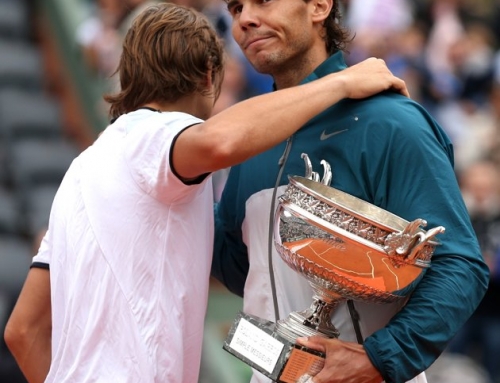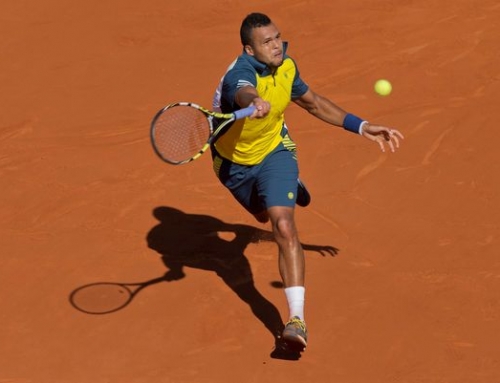 If you watch enough tennis, you see beyond the names most people know, beyond Federer, Nadal, beyond Tsonga, Roddick, beyond Querrey, and start to see names like Andreas Seppi, Philipp Kohlschreiber, Thomaz Bellucci. You’ll see names like Victor Hanescu and Janko Tipsarevic. These are the guys whose ranks typically float in the 30s or 40s, and occasionally, when things go bad, they’ll slip down to 100 or so, but their names seem familiar. They good, just not Slam worthy.
If you watch enough tennis, you see beyond the names most people know, beyond Federer, Nadal, beyond Tsonga, Roddick, beyond Querrey, and start to see names like Andreas Seppi, Philipp Kohlschreiber, Thomaz Bellucci. You’ll see names like Victor Hanescu and Janko Tipsarevic. These are the guys whose ranks typically float in the 30s or 40s, and occasionally, when things go bad, they’ll slip down to 100 or so, but their names seem familiar. They good, just not Slam worthy.
However, a Slam has many more players than most tournaments. A tournament is considered big with 56 players. The largest non-Slams are events like Miami and Indian Wells that run 10 days and have 96 players. The Slams have 128 players. So you’ll see players you’ve really never heard of. Many of them toil in the Challenger circuit, far from the view of the public. The few that greet the public eye are often out in a round, and then they’re gone, playing elsewhere.
Most of these players are actually pretty good. Only the wildcards tend to be ranked so low that they make the Slams despite ranked around 300 or lower. Those who get in are typically ranked above 200 or so. And although the casual fan disdains these players (why play, if you’ll never contend for any title?), these players are living their dream, or at least living the career that only 1000 other people in the world are living.
And occasionally, just occasionally, someone surprises, wins out of nowhere, and for a round, they are pretty happy.
Today, that man was Grega Zemlja of Slovenia. He’s 23, ranked 142 in the world, and that’s all I know about him. He’s been playing the Challengers where he’s had some success, beating players ranked 100 and 200 and lower. One of his better tournaments was in Honolulu where he lost to Michael Russell in the finals, but beat several players including Kevin Anderson in the semifinals.
Zemlja isn’t ranked high enough to play directly in the main draw. He’d need to be ranked about 80 or so to get in based on his ranking. He had to go through qualifying which is a mini-tournament, typically 3 rounds long, where the winners get inserted into the main draw. Sometimes, a qualifier gets a little lucky and plays another qualifier. There’s a 3 in 4 chance of playing a non-seed. The worst is to open up against a seed or a high seed, but sometimes this can create some excitement, just like veteran Michael Yani, who nearly knocked out Lukas Lacko, pushing him to 12-10 in the fifth.
Zemlja, however, must have hit a perfect moment, the equivalent of a low seed in March Madness taking out a favorite in the tourney. Zemlja drew Juan Monaco of Argentina. Monaco is a very solid clay courter, a guy most players don’t want to face. He’s had victories over players ranked higher than him including Andy Murray (to be fair, it was on clay). But Zemlja took the first set in a tiebreak, and had to think, this is great.
He lost the second, 6-3, but apparently still believed in his game, and took the third set, 7-5. Then, he broke in the third and held that break to win it 6-3. Monaco loses in the first round! It’s probably one of those rare times that Zemlja hears his name being cried out by fans eager for the upset. He takes on hard hitting Gabashvili in the next round. The winner of that likely gets Andy Roddick in the 3rd round.
Another player that nearly exited in the first round was Andy Roddick. Roddick has had to deal with injuries in the last year or so. After the US Open, as Roddick was complaining about the long tour in Shanghai, Roddick had to retire and took the rest of the year off to recover. Roddick played in Brisbane and Melbourne and did well in the Australian Open. He hit a peak at Indian Wells and Miami where he reached the finals of both and won Miami.
As the rest of the tour headed to clay, Roddick took that time off. He skipped Monte Carlo, then elected to skip Rome. He planned to play Madrid, but got ill, and skipped Madrid, and then headed to Paris to train.
His first round opponent was veteran Jarkko Nieminen, perhaps the best player to come out of Finland. Nieminen is a lefty with big shots, but has seen better days. Even so, with Roddick’s training less than idea and with Nieminen trying to finish points off early, Roddick found himself down 2 sets to 1. Roddick took the first set 6-2, and Nieminen took the next two, 6-4 and 6-4. The third set went to a tiebreak which Roddick won comfortably, 7-4. Roddick then took the final set, 6-3 to eke out a victory.
Roddick’s reward is a qualifier in round 2 and then a qualifier in round 3 (two qualifiers play each other in round 2 and the winner would play Roddick, if Roddick gets there). So Roddick will be highly favored to get through 3 rounds before he meets the formidable, David Ferrer, and that’s probably where Roddick exits the French unless he serves well.
Verdasco and Ferrero had easy first round matches winning in straight sets. Although Sam Querrey has played well on clay, he’s had problems playing Ginepri who he lost to in Indianapolis last year. Ginepri kept his errors down and did well on his own serve and beat his fellow American in four sets: 4-6, 7-6(3), 6-4, 6-2.
Melzer, Seppi, Kohlschreiber, Serra, and Gabashvili all won in straight sets.
Meanwhile, Gianni Mina, probably the lowest ranked wildcard playing, an 18 year old player still in the junior French Open, looking every bit like mini-Gael Monfils with his stretchy moves is losing somewhat badly to Rafael Nadal. He has had a reasonable junior career winning the Boy’s 18 in the Orange Bowl, so his future is potentially bright.
Even though his chances against Nadal are like nil, it’s nice to be ranked 655 and win a handful of games. With his 4 games in 2 sets, he’s won 3 more games than Verdasco won in the Monte Carlo final. At least, at this age, he can believe his game can improve tremendously in the next few years. Like most players, Mina has been trying to attack and use his athleticism, but like most players, he’s either missing too many shots or Nadal is just too good.
Nadal appears to have modified his playing strategy. These days, he is playing right near the baseline. Rafa used to play way back, several meters behind the baseline, but that left him somewhat vulnerable to being pushed arond. Now, he is willing to make more errors but take a more aggressive stance. Rafa is also wearing a watch worth more than half a million dollars making that left arm even more valuable than it already is.
Ferrer just won his first round match comfortably. Zeballos and Fischer are in a five setter.




![[French Open] The tactics of the Djokovic-Nadal semifinals](https://www.essentialtennis.com/wp-content/uploads/2013/06/20130607nole-500x383.jpg)
![[French Open, SF] David Ferrer defeats Tsonga in straight sets to reach first Slam final](https://www.essentialtennis.com/wp-content/uploads/2013/06/20130607ferrer-500x383.jpg)
![[French Open, SF] Nadal escapes epic 5-setter with win over Djokovic, to compete for 8th title](https://www.essentialtennis.com/wp-content/uploads/2013/06/20130607rafa-500x383.jpg)
